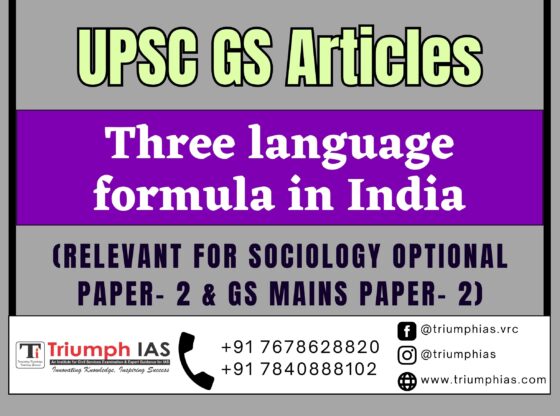Three language formula in India
Relevant for sociology optional Paper- 2 & GS Mains Paper- 2

The Three Language Formula in India is a language policy that was introduced by the Indian government in 1968. The policy aims to promote multilingualism and linguistic diversity in the country by encouraging the study of three languages in schools. These languages are typically the mother tongue or regional language, Hindi, and English. The Three Language Formula has been a subject of much debate and controversy over the years, with some arguing that it promotes Hindi at the expense of regional languages and others arguing that it is necessary for national integration and communication.
The Three Language Formula was first introduced in the National Policy on Education (NPE) in 1968. The policy was revised in 1986 and again in 1992, with minor changes made to the language formula. The basic idea behind the policy was to encourage the study of three languages in schools: the mother tongue or regional language, Hindi, and English. The policy was designed to promote linguistic diversity in the country and to provide a common language for communication between different regions.
The mother tongue or regional language is the language that is spoken by the majority of people in a particular state or region. For example, in Tamil Nadu, the mother tongue is Tamil, while in Maharashtra, it is Marathi. Hindi is the official language of the central government and is spoken by a large number of people in the northern states of India. English is the language of international communication and is widely used in business, education, and government.
The Three Language Formula is implemented in schools in different ways, depending on the state or region. In some states, such as Tamil Nadu, the mother tongue is given priority and is taught as the first language, followed by Hindi and English. In other states, such as Uttar Pradesh, Hindi is given more importance and is taught as the first language, followed by the mother tongue and English. In some states, such as Kerala, English is given more emphasis and is taught as the first language, followed by the mother tongue and Hindi.
The implementation of the Three Language Formula has been a subject of much debate and controversy over the years. One of the main criticisms of the policy is that it promotes Hindi at the expense of regional languages. Many people in non-Hindi speaking states feel that Hindi is being imposed on them and that the policy undermines the linguistic diversity of the country. They argue that the mother tongue or regional language should be given more importance and that Hindi should not be compulsory.
Another criticism of the policy is that it is not practical and that it puts too much burden on students. Learning three languages can be difficult, especially for students who are not proficient in their mother tongue or regional language. Some argue that the policy should be revised to make it more flexible and to allow students to choose the languages they want to study.
Despite these criticisms, the Three Language Formula has many supporters who argue that it is necessary for national integration and communication. India is a vast and diverse country with many different languages and cultures. The Three Language Formula provides a common language for communication between different regions and helps to promote national unity. It also helps students to develop their language skills and to become more proficient in different languages.
In recent years, there have been calls to revise the Three Language Formula to make it more flexible and to take into account the linguistic diversity of the country. Some states have already made changes to the policy to give more importance to the mother tongue or regional language. For example, in Tamil Nadu, the government has introduced a new policy that gives priority to the mother tongue and allows students to choose between Hindi and English as the second language.
In conclusion, the Three Language Formula in India is a language policy that aims to promote multilingualism and linguistic diversity in the country. The policy encourages the study of three languages in schools: the mother tongue or regional language, Hindi and English. While the policy has faced criticism for promoting Hindi at the expense of regional languages and putting too much burden on students, it has also been praised for its role in promoting national integration and communication. As India continues to evolve and embrace its linguistic diversity, it will be important to continue to evaluate and revise the Three Language Formula to ensure that it is meeting the needs of all students and promoting multilingualism in a way that is inclusive and effective.
For more such free UPSC notes, Articles, News & Views Join our Telegram Channel. https://t.me/triumphias
Click the link below to see the details about the UPSC – Civils courses offered by Triumph IAS. https://triumphias.com/pages-all-courses.php


